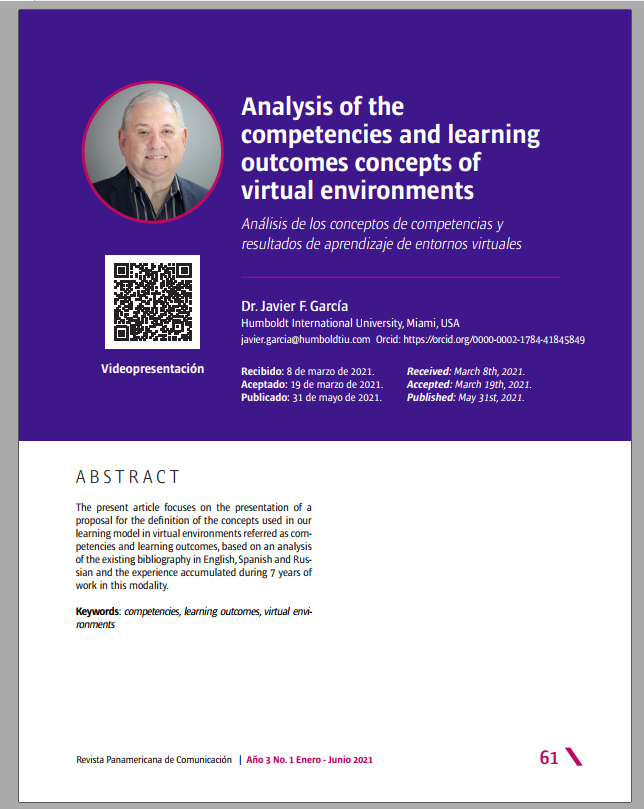Análisis de los conceptos de competencias y resultados de aprendizaje de entornos virtuales
Contenido principal del artículo
Resumen
El presente artículo se centra en la presentación de una propuesta de definición de los conceptos utilizados en nuestro modelo de aprendizaje en entornos virtuales denominados competencias y resultados de aprendizaje, basada en el análisis de la bibliografía existente en inglés, español y ruso y en la experiencia acumulada durante 7 años de trabajo en esta modalidad.
Detalles del artículo
Sección
Artículos

Esta obra está bajo una licencia internacional Creative Commons Atribución-NoComercial-SinDerivadas 4.0.
Cómo citar
García, J. F. . (2021). Análisis de los conceptos de competencias y resultados de aprendizaje de entornos virtuales. Revista Panamericana De Comunicación, 3(1), 61-67. https://doi.org/10.21555/rpc.v0i1.2351
Referencias
Adam Manley, R., & Zinser, R. (2012). A Delphi study to update CTE teacher competencies. Education+ Training, 54(6), 488-503.
Bereczki, E. O., & Karpati, A. (2018). Teachers’ beliefs about creativity and its nurture: A systematic review of the recent research literature. Educational Research Review, 23, 25-56.
Biggs, J. (1999). What the student does: Teaching for enhanced learning. Higher education research & development, 18(1), 57-75.
Brown, S., & Knight, P. (2012). Assessing learners in higher education. Routledge.
Burke, J. W. (Ed.). (1989). Competency based education and training. Psychology Press.
Kennedy D. 2006. Writing and using learning outcomes: a practical guide, Cork, University College Cork.
Kennedy, D., Hyland, A., & Ryan, N. (2009). Learning outcomes and competences. Introducing Bologna Objectives and Tools, 2-3.
Jenkins, A., & Unwin, D. (2001). How to write learning outcomes. Disponible en https://www.ubalt.edu/cas/faculty/faculty-matters/How%20to%20write%20student%20learning%20outcomes.
Leadbeater, C. (2008). What’s Next?: 21 Ideas for 21st Century Learning. Innovation Unit.
Le Boterf, G. (2010). Agir et réussir avec compétence (5e édition). In Construire les compétences individuelles et collectives.
Lobanova, T., & Shunin, Y. (2008). Competence-based education: A common European strategy. Computer Modelling and New Technologies, 12(2), 45-65.
McLoughlin, C., & Lee, M. (2008). Mapping the digital terrain: New media and social software as catalysts for pedagogical change. Hello! Where are you in the landscape of educational technology? Proceedings ascilite Melbourne 2008, 641-652.
Moon, Y. L. (2007). Education reform and competency-based education. Asia pacific education review, 8(2), 337-341.
Mulder, M., Weigel, T., & Collins, K. (2007). The concept of competence in the development of vocational education and training in selected EU member states: a critical analysis. Journal of Vocational Education & Training, 59(1), 67-88.
Tobón S., (2010). Formación integral y competencias. Pensamiento complejo, currículo, didáctica y evaluación, 3a ed., Centro de Investigación en Formación y Evaluación CIFE, Bogotá, Colombia, ECOE Ediciones.
Winterton, J., Mulder, M., Gulikers, J., Biemans, H., & Wesselink, R. (2009). The new competence concept in higher education: error or enrichment?. Journal of European industrial training. Vol. 33 No. 8/9, 2009 pp. 755-770.
Zimnyaya, I. A. (2003). Key Competencies-a new paradigm of education result. Higher education today, 5, 34-42.
Bereczki, E. O., & Karpati, A. (2018). Teachers’ beliefs about creativity and its nurture: A systematic review of the recent research literature. Educational Research Review, 23, 25-56.
Biggs, J. (1999). What the student does: Teaching for enhanced learning. Higher education research & development, 18(1), 57-75.
Brown, S., & Knight, P. (2012). Assessing learners in higher education. Routledge.
Burke, J. W. (Ed.). (1989). Competency based education and training. Psychology Press.
Kennedy D. 2006. Writing and using learning outcomes: a practical guide, Cork, University College Cork.
Kennedy, D., Hyland, A., & Ryan, N. (2009). Learning outcomes and competences. Introducing Bologna Objectives and Tools, 2-3.
Jenkins, A., & Unwin, D. (2001). How to write learning outcomes. Disponible en https://www.ubalt.edu/cas/faculty/faculty-matters/How%20to%20write%20student%20learning%20outcomes.
Leadbeater, C. (2008). What’s Next?: 21 Ideas for 21st Century Learning. Innovation Unit.
Le Boterf, G. (2010). Agir et réussir avec compétence (5e édition). In Construire les compétences individuelles et collectives.
Lobanova, T., & Shunin, Y. (2008). Competence-based education: A common European strategy. Computer Modelling and New Technologies, 12(2), 45-65.
McLoughlin, C., & Lee, M. (2008). Mapping the digital terrain: New media and social software as catalysts for pedagogical change. Hello! Where are you in the landscape of educational technology? Proceedings ascilite Melbourne 2008, 641-652.
Moon, Y. L. (2007). Education reform and competency-based education. Asia pacific education review, 8(2), 337-341.
Mulder, M., Weigel, T., & Collins, K. (2007). The concept of competence in the development of vocational education and training in selected EU member states: a critical analysis. Journal of Vocational Education & Training, 59(1), 67-88.
Tobón S., (2010). Formación integral y competencias. Pensamiento complejo, currículo, didáctica y evaluación, 3a ed., Centro de Investigación en Formación y Evaluación CIFE, Bogotá, Colombia, ECOE Ediciones.
Winterton, J., Mulder, M., Gulikers, J., Biemans, H., & Wesselink, R. (2009). The new competence concept in higher education: error or enrichment?. Journal of European industrial training. Vol. 33 No. 8/9, 2009 pp. 755-770.
Zimnyaya, I. A. (2003). Key Competencies-a new paradigm of education result. Higher education today, 5, 34-42.

